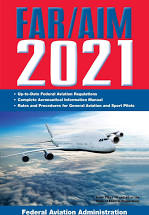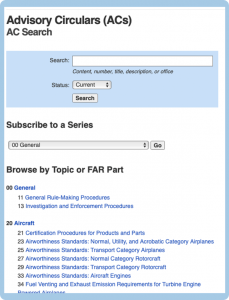Do you know the difference between the FAR’s and AC’s?
 Do you know the difference? This is area of confusion among some pilots. The rules, that is, the Federal Aviation Regulations, aka the ‘F-A-Rs’ or ‘regs’, for short, spell out the many requirements that we follow, as pilots, mechanics, and air traffic controllers, to operate an aircraft safely, in the National Airspace System (NAS), and stay ‘in compliance’. The FAR’s are formal regulations that have been adopted by the FAA. They have been authorized by an Act of Congress.
Do you know the difference? This is area of confusion among some pilots. The rules, that is, the Federal Aviation Regulations, aka the ‘F-A-Rs’ or ‘regs’, for short, spell out the many requirements that we follow, as pilots, mechanics, and air traffic controllers, to operate an aircraft safely, in the National Airspace System (NAS), and stay ‘in compliance’. The FAR’s are formal regulations that have been adopted by the FAA. They have been authorized by an Act of Congress.
 There is a saying that regulations are written in ‘blood’, because frequently, following an aircraft accident with fatalities, a new regulation emerges to address whatever happened. And there is a book that is issued every year, with the most up-to-date compilation of rules, and procedures. That is the ‘XXXX’ year FAR/AIM. It’s also available as an app, for your device. Every pilot should have a copy of this and refer to it as needed.
There is a saying that regulations are written in ‘blood’, because frequently, following an aircraft accident with fatalities, a new regulation emerges to address whatever happened. And there is a book that is issued every year, with the most up-to-date compilation of rules, and procedures. That is the ‘XXXX’ year FAR/AIM. It’s also available as an app, for your device. Every pilot should have a copy of this and refer to it as needed.
While we are on the topic, the AIM, or Aeronautical Information Manual, is a collection of information, best practices, and explanation of regulatory materials. Though the AIM is ‘not regulatory’, it does provide guidance on how to proceed with a given procedure. And sometimes, the guidance is the rule.
Then there are the FAA’s Advisory Circulars, or AC’s, for short. AC’s cover a wide range of topics, and are numbered accordingly. AC’s are typically non-regulatory. The FAA states this on its website when referring to a specific AC; “This AC is not mandatory and does not constitute a regulation. It is issued for guidance purposes and to outline a method of compliance with the rules.”
AC’s cover a wide range of topics, and are numbered from 00 through 211, but are not inclusive. For example;
AC 00 – General
AC 20 – Aircraft
AC 60 – Airmen
AC 70 – Airspace
Each of these has one or more subsections containing more specific guidance as applicable. From another source, “… Advisory Circulars are intended to be informative in nature and not regulatory; however, many times they describe actions or advice that the FAA expects to be implemented or followed.”
So, AC’s are typically non-regulatory guidance, and contain advice and methods of complying with FAA Regulations as they are written. They sometimes also provide additional explanatory materials.
I hope this helps to clear up some of the confusion regarding the difference between FAR’s and AC’s.
Fly safely!
John




the clarity of writing here is excellent. makes it totally accessible for even landlubbers like me. also your expertise adds a powerful note of confidence that those in the skies are doing so with utmost precision and carefulness. as you peel back various aspects of flying and flight safety, i find it endlessly fascinating.